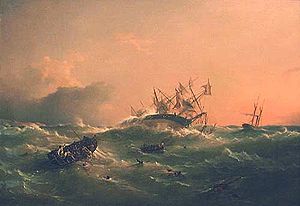HMS Orpheus (1861)

Richard Brydges Beechey's 1863 painting of the disaster.
|
|
| History | |
|---|---|
|
|
|
| Name: | HMS Orpheus |
| Namesake: | Orpheus, a figure from Greek mythology, king of the Thracian tribe Cicones. |
| Ordered: | 1 April 1857 |
| Builder: | Chatham Dockyard |
| Laid down: | 12 May 1858 |
| Launched: | 23 June 1860 |
| Commissioned: | Portsmouth 24 October 1861 |
| Fate: | Wrecked 7 February 1863 |
| General characteristics | |
| Class and type: | Jason-class corvette |
| Displacement: | 2,365 tons |
| Tons burthen: | 1,702 bm |
| Length: | 225 ft (69 m) |
| Beam: | 40 ft (12 m) |
| Draught: |
|
| Installed power: |
|
| Propulsion: |
|
| Sail plan: | Full-rigged ship |
| Speed: | 11.1 knots (20.6 km/h) |
| Complement: | 258 |
| Armament: |
|
HMS Orpheus was a Jason-class Royal Navy corvette that served as the flagship of the Australian squadron. Orpheus sank off the west coast of Auckland, New Zealand on 7 February 1863: 189 crew out of the ship's complement of 259 died in the disaster, making it the worst maritime tragedy to occur in New Zealand waters.
HMS Orpheus (named after the Greek hero) was a Jason-class corvette, a screw-driven vessel built in Chatham Dockyard in Kent, England, in 1861. She was owned by the Royal Navy, and was 69 metres long with a crew of 259.
Orpheus was commanded by Captain Robert Heron Burton. She displayed a broad pennant to indicate that Commodore William Farquharson Burnett, senior officer of HM ships and vessels on the Australian and New Zealand Stations, was also on board.
She was wrecked when delivering naval supplies and troop reinforcements to Auckland for the New Zealand land wars.
Orpheus's first journey was in December 1861 flying the pennant of Commodore W Farquharson Burnett CB. She sailed from Plymouth Sound, initially for convoy duty off Canada, which delayed her voyage to Sydney. On 31 January 1863, Burnett set out on a mission to New Zealand. The mission was not to reinforce the British ships already taking part in the New Zealand Wars, but to arrange for the withdrawal of two Royal Navy sloops – Miranda, stationed in Manukau harbour, and Harrier. They were to rendezvous in the Waitemata Harbour. Orpheus was behind schedule, and Burnett decided to save some time by cutting through Manukau Harbour rather than going by the intended course of rounding North Cape and sailing down the East Coast of Northland.
...
Wikipedia
